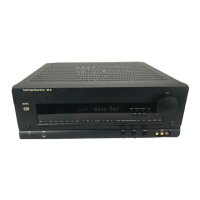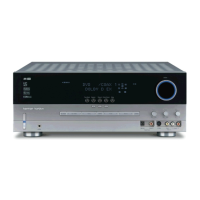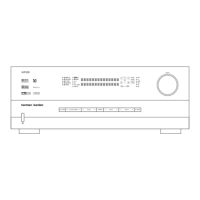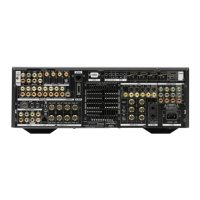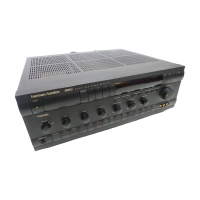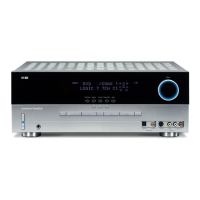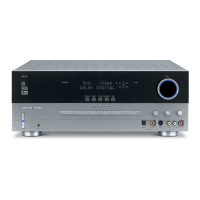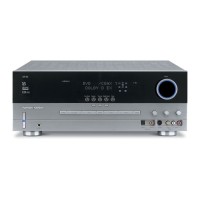OPERATION
38 OPERATION
the “.1” channel referred to when you see these systems
described as “5.1,” “6.1” or “7.1.” The bass channel is
separate from the other channels, but since it is inten-
tionally bandwidth-limited, sound designers have given
it that unique designation. When a digital soundtrack
is playing, the number of channels available will
vary according to the way in which the program was
recorded. Although most movies recorded with digital
sound have 5.1 soundtracks, some have 6.1 or 7.1
sound, while others retain the original two-channel or
even monaural sound. When the program source is a
broadcast, cable or satellite delivered digital program,
only one type of soundtrack may be delivered at a
time, while optical sources such as DVD may provide
more than one audio option. In either case, the deci-
sion of what type of sound track and how many chan-
nels to offer is up to the program’s producer. With the
AVR 645 you are able to not only play back the origi-
nal compatible digital format, but using the processing
power of the Texas Instruments DSP processor, it is
possible to decode the basic digital track for 2.0 or
5.1 sound and then select an additional “post-pro-
cessing” mode to deliver additional channels.
Dolby Digital
Dolby Digital is the default format for DVD discs and
for the (ATSC) high-definition system used in the
United States and Canada. It is also used by the digital
satellite program services and is available on most
digital cable set-top boxes. When the AVR 645 is
connected to a blue-laser-based high-definition optical
disc player via an HDMI, coaxial or optical digital
connection, the soundtrack from the player may be
available in the standard Dolby Digital or DTS format,
so that it may be decoded by the AVR.
An optional, external RF demodulator is required to
use the AVR 645 to listen to the Dolby Digital sound-
tracks available on laser discs. Connect the RF output
of the LD player to the demodulator and then connect
the digital output of the demodulator to the
Optical
or Coaxial Inputs KMab of the AVR 645. A
demodulator is not required for use with high-definition
optical disc or DVD players, or with DTS-encoded
laser discs.
In order to provide maximum playback compatibility
with DVDs, the AVR 645 receiver will always default
first to the playback mode embedded in a disc’s digital
“flag” information. For Dolby Digital discs, the following
playback modes are initially selected after the AVR
locks on to the incoming digital audio data stream:
• When a Dolby Digital 5.1 data stream is detected,
the choice of which surround mode is activated is
determined by the setting on the
DEFAULT
SURR
line of the SURROUND CONFIG
menu (Figure 21), as shown on page 26.
• When a disc with the Dolby Digital EX flag is played,
your system will automatically switch to the EX mode
when seven main speakers are available.
• When a disc with 2.0 Dolby Digital data is detected,
the default mode is Dolby Digital with Pro Logic II
postprocessing when you have a 5.1 speaker sys-
tem, or Dolby Digital with Dolby Pro Logic IIx post-
processing when you have a 7.1 speaker system.
• Depending on the number of speaker channels
available in your system, once the AVR locks on
to the digital signal, you may select any surround
mode or postprocessing option that is available,
based on the incoming data stream’s possible
restrictions and the number of speakers in your
system. For example, when a 5.1 or 2.0 audio
stream is in use, you may select alternate post-
processing such as Logic 7/7.1-channel Movie
mode postprocessing to create the rear surrounds
in 7.1 speaker systems.
DTS
DTS is another digital audio system that is capable
of delivering 5.1 or 6.1 discrete or matrix sound field
reproduction. Although both DTS and Dolby Digital are
digital, they use different methods of encoding the sig-
nals, and thus they require different decoding circuits
to convert the digital signals back to analog.
DTS-encoded soundtracks are available on select DVD
and LD discs, as well as on special audio-only DTS
discs. You may use any LD or CD player equipped
with a digital output to play DTS-encoded discs with
the AVR 645. All that is required is to connect the
player’s output to either an
Optical or Coaxial Input
on the rear panel ab or front panel KM.
In order to listen to DVDs encoded with DTS sound-
tracks, the DVD player must be compatible with the
DTS signal, which is indicated by a DTS logo on the
player’s front panel. Early DVD players may not be
able to play DTS-encoded DVDs. If you are in doubt
as to the capability of your DVD player to handle DTS
discs, consult the player’s owner’s manual.
When the AVR 645 is connected to a blue-laser-
based high-definition optical disc player via an HDMI,
coaxial or optical digital connection, the soundtrack
from the player is also available in the standard DTS
format so that it may be decoded by the AVR.
NOTE:
• Some DVD players have a default setting that does
not pass through the DTS signal. Before playing
DVDs with a DTS soundtrack, make certain that
the
settings in your DVD player have been properly
adjusted
so that DTS audio is passed through.
Consult the owner’s manual for your DVD player for
more information on making these settings.
• When selecting surround modes, any mode where
the setting in its mode group (Dolby, DTS, Logic 7,
PCM, etc.) has been set to
OFF in one of the
SURROUND CONFIG menus will not
appear. You may change the settings in this list at
any time by following the instructions on page 26.
Selecting a Digital Source
To utilize either digital mode, you must have properly
connected a digital source to the AVR 645. Connect
the digital outputs from DVD players, HDTV receivers,
satellite systems or CD players to the
Optical or Coaxial
Inputs
KMab. In order to provide a backup signal
and a source for analog stereo recording, the analog
outputs provided on digital source equipment should
also be connected to their appropriate inputs on the
AVR 645 rear panel (e.g., connect the analog stereo
audio output from a DVD to the
DVD Audio Inputs Z
on the rear panel when you connect the source’s
digital outputs).
If you have not already configured an input for a
digital source using the on-screen menus, as shown
on page 24, first select the input using the remote or
front-panel controls, as outlined in this manual. Next,
press the
Digital Select ButtonE, then press the
‹
/
›
Navigation Buttons D
©
on the remote or
the
‹
/
›
Button H on the front panel to
choose any
of the
OPTICAL or COAXIAL
inputs, as they
appear in the
Upper Display Line # or on-screen
display. When the digital source is playing, the
AVR 645 will automatically detect which type of digital
data stream is being decoded and display that infor-
mation in the
Upper Display Line #.
When both a digital and an analog connection are
made between a source device and the AVR, the digi-
tal input is the default. If the digital stream is not pres-
ent or is interrupted, the unit will automatically switch
over to the analog inputs for the selected source.
If you wish to disable the auto-polling feature, you
may do so by following the instructions shown for the
IN/OUT SETUP menu (Figure 2), as shown
on page 24
.
Digital Bitstream and Surround Mode Indications
When a digital source is playing, the AVR 645 senses
the type of bitstream data that is present, and auto-
matically selects the proper surround mode. For exam-
ple, DTS bitstreams will cause the unit to switch to
DTS decoding, and Dolby Digital bitstreams will enable
Dolby Digital decoding. When the unit senses PCM
data from CDs or LDs, you may select any of the stan-
dard Dolby or DTS surround modes or Logic 7. Since
the range of available surround modes is dependent
on the type of digital data that is present, the AVR 645
shows you what type of signal is present to help you
understand the choice of modes.
HKP1445AVR645om 6/7/06 6:35 PM Page 38
AVR645
harman/kardon
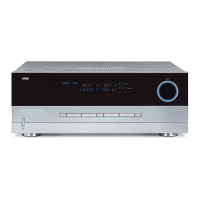
